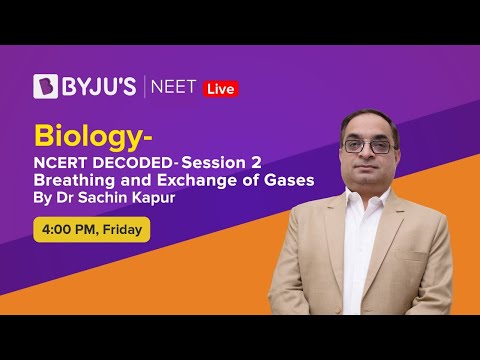Get access to the most important set of questions on chapter Breathing and the exchange of gases for NEET. Listed below are the questions that have already appeared in the NEET question papers from previous years.
Important NEET Questions on Class 11 Chapter 17 Breathing And Exchange of Gases
1. Lungs are made up of air-filled sacs, the alveoli. They do not collapse even after forceful expiration, because of (NEET 2017)
A. expiratory reserve volume
B. inspiratory reserve volume
C. residual volume
D. tidal volume
2. Lungs do not collapse between breaths and some air always remains in the lungs which can never be expelled because (NEET – II 2016)
A. there is a positive intrapleural pressure
B. there is negative intrapleural pressure pulling at the lung walls
C. there is negative pressure in the lungs
D. pressure in the lungs is higher than the atmospheric pressure
3. Name the chronic respiratory disorder caused mainly by cigarette smoking
(NEET – I 2016)
A. Respiratory Alkalosis
B. Respiratory Acidosis
C. Asthma
D. Emphysema
4. Approximately 70% of carbon dioxide absorbed by the blood will be transported to the lungs (2014)
A. as carbamino hemoglobin
B. by binding to R.B.C
C. in the form of dissolved gas molecules
D. as bicarbonate ions
5. People who have migrated from the planes to an area adjoining Rohtang pass about 6 months back (2012)
A. are not physically fit to play games like football
B. have more RBCs and their hemoglobin has a lower binding affinity to O2
C. have the usual RBC count, but their hemoglobin has very high binding affinity to O2
D. suffer from altitude sickness with symptoms like nausea, fatigue, etc
6. A large proportion of oxygen remains unused in the human blood even after its uptake by the body tissue. This O2 (2011)
A. helps in releasing more O2 to the epithelial tissues
B. is enough to keep oxyhemoglobin saturation at 96%
C. raises the pCO2 of blood to 75mm of Hg
D. acts as a reserve during muscular exercise
7. Bulk of carbon dioxide (CO2) released from body tissues into the blood is present as
(Mains 2011)
A. carbamino-hemoglobin in RBCs
B. 70% carbamino-hemoglobin and 30% as bicarbonate
C. free CO2 in blood plasma
D. bicarbonate in blood plasma and RBCs
8. What is true about RBCs in humans? (2010)
A. they transport about 80% oxygen only and the rest 20% of it is transported in the dissolved state in blood plasma
B. they transport 99.5% of O2
C. they carry about 20-25% of CO2
D. they do not carry CO2 at all
9. The hemoglobin of a human foetus (2009)
A. its affinity for oxygen is the same as that of an adult
B. has a lower affinity for oxygen than that of an adult
C. has a higher affinity for oxygen than that of an adult
D. has only 2 protein subunits instead of 4
10. Pick the incorrect statement (2006)
A. the presence of non-respiratory air sacs increases the efficiency of respiration in birds
B. the residual air in the lungs slightly decreases the efficiency of respiration in mammals
C. the principle of counter current flow facilitates efficient respiration in gills of fishes
D. in insects, circulating body fluids serve to distribute oxygen to tissues
| Question | Answer Key |
| 1 | C |
| 2 | B |
| 3 | D |
| 4 | D |
| 5 | B |
| 6 | D |
| 7 | D |
| 8 | C |
| 9 | C |
| 10 | D |
Also see:
Explore other important NEET questions of Biology chapters, at BYJU’S.
See More:
| Important NEET Notes for – Breathing and exchange of gases |
| NEET MCQs |

Comments